
Malva phoenicea, often still known under the synonyms Lavatera phoenicea and Navaea phoenicea, is a large shrub of the family Malvaceae and tribe Malveae, endemic to the island of Tenerife in the Canary Islands.

Malva sylvestris is a species of the mallow genus Malva in the family of Malvaceae and is considered to be the type species for the genus. Known as common mallow to English-speaking Europeans, it acquired the common names of cheeses, high mallow and tall mallow as it migrated from its native home in Western Europe, North Africa and Asia through the English-speaking world.

Malva parviflora is an annual or perennial herb that is native to Northern Africa, Europe and Asia and is widely naturalised elsewhere. Common names include cheeseweed, cheeseweed mallow, Egyptian mallow, least mallow, little mallow, mallow, marshmallow, small-flowered mallow, small-flowered marshmallow and smallflower mallow. M. parviflora leaf extracts possess anti-inflammatory and antioxidant activities. It has a decumbent or erect habit, growing up to 50 cm in height. The broad leaves have 5 to 7 lobes and are 8 to 10 cm in diameter. It has small white or pink flowers with 4 to 6 mm long petals.

Malva multiflora is a species of flowering plant in the mallow family known by the common names Cornish mallow and Cretan hollyhock. It is native to western Europe, North Africa, and the Mediterranean Basin, and it is naturalized in areas with a Mediterranean climate, such as parts of Australia, South Africa, and California. This is an annual or biennial herb growing a tough, somewhat hairy stem to a maximum height between 1 and 3 meters. The leaves are multilobed with flat or wavy edges, slightly hairy, and up to 10 centimeters long. The plant bears small pink or light purple flowers with petals just over a centimeter long. The fruit is disc-shaped with 7 to 10 segments.
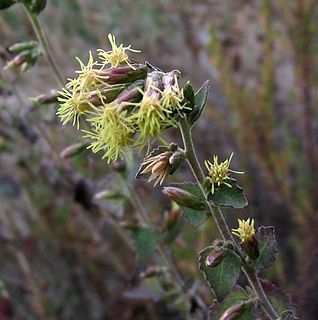
Brickellia californica, known by the common name California brickellbush, is a species of flowering plant in the family Asteraceae.

Constancea is a monotypic genus of flowering plants in the family Asteraceae containing the single species Constancea nevinii, which is known by the common name Nevin's woolly sunflower. It is endemic to three of the Channel Islands of California, where it grows in coastal scrub habitat. This is a small shrub or subshrub generally growing up to one or 1.5 meters tall, and taller when an erect form, with a branching, woolly stem. The whitish, woolly oval leaves may be up to 20 centimeters long and are divided into many narrow lobes with edges curled under. The inflorescence is a cluster of 10 to 50 or more small flower heads, each on a short peduncle. The flower head has a center of hairy, glandular, star-shaped yellow disc florets and a fringe of four to nine yellow ray florets, each about 2 millimeters long. The fruit is an achene a few millimeters long with a small pappus at the tip.
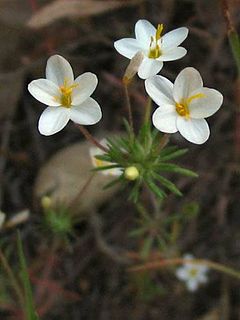
Leptosiphon parviflorus is a species of flowering plant in the phlox family known by the common name variable linanthus.
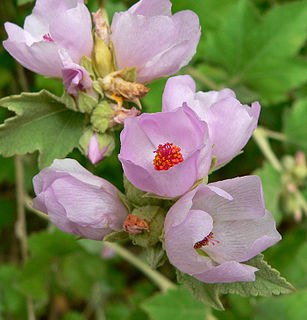
Malacothamnus fasciculatus, with the common name chaparral mallow, is a species of flowering plant in the mallow family. It is found in far western North America.

Orobanche californica, known by the common name California broomrape, is a species of broomrape. It is a parasitic plant growing attached to the roots of other plants, usually members of the Asteraceae.

Sidalcea calycosa is a species of flowering plant in the mallow family known by the common names annual checkerbloom, checker mallow, and vernal pool checkerbloom.

Sidalcea diploscypha is a species of flowering plant in the mallow family known by the common name fringed checkerbloom. It is endemic to California, where it grows in the woodlands and valleys of the central part of the state.

Sidalcea glaucescens is a species of flowering plant in the mallow family known by the common name waxy checkerbloom.
Sidalcea hartwegii is a species of flowering plant in the mallow family known by the common names valley checkerbloom and Hartweg's checkerbloom.
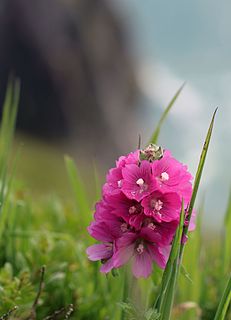
Sidalcea hirsuta is a species of flowering plant in the mallow family known by the common name hairy checkerbloom.
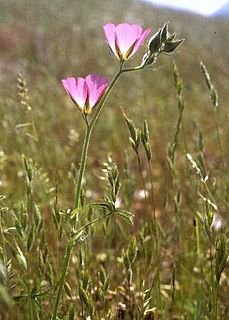
Sidalcea keckii is a rare species of flowering plant in the mallow family, known by the common names Keck's checkerbloom and Keck's checkermallow.

Sidalcea oregana is a species of flowering plant in the mallow family known by the common name Oregon checkerbloom.

Sidalcea reptans is a species of flowering plant in the mallow family known by the common name Sierra checkerbloom and Sierra checker mallow.

Sidalcea robusta is an uncommon species of flowering plant in the mallow family known by the common name Butte County checkerbloom.

Sidalcea stipularis is a rare species of flowering plant in the mallow family, known by the common name Scadden Flat checkerbloom.

Arctostaphylos gabilanensis is a rare species of manzanita known by the common name Gabilan manzanita.




















